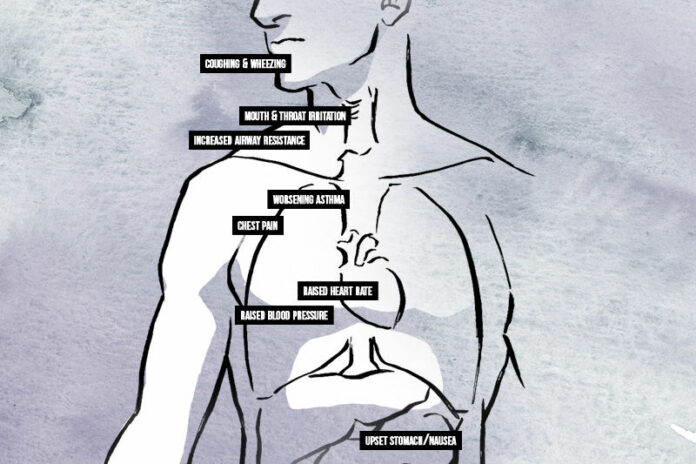Chemicals may pose short and long-term health consequences for teens
To some middle school and older elementary school aged children vaping, which produces an aerosol from a heated and flavored nicotine liquid may seem like a harmless and fun thing to do with friends, however, the reality of vaping paints a dangerous picture.
The California Healthy Kids survey found that vaping has increased by almost double in the last two years and pediatricians are worried about the short- and long-term effects that vaping can pose. However, the most concerning aspect with children taking up the vape pen is the toxic cocktail of chemicals that can cause serious health risks and affect developing minds and bodies.
E-juices or liquid used in a vape pipe or tank are often disguised with a sweet flavor such as cotton candy, yet underneath the mask lies a toxic soup of the same chemicals found in antifreeze and even in laxatives.
“The solutions in the vapor contain antifreeze, carcinogens that can cause cancer and nicotine, which can become addictive. In a developing brain, it is more harmful than it is to adults,” said Shannon Udovic-Constant, a Kaiser Permanente pediatrician and vice chairperson of the California Medical Association board.
The human brain keeps developing until age 25 and according to the Centers for Disease Control and Prevention, using nicotine in adolescence can harm parts of the brain that control attention, control, learning, mood and impulse control. It can also affect the way memory or skill synapses are formed in the developing brain.
Other materials found in e-juices include glycerol, diacetyl and formaldehyde, according to Brian Ng, Kaiser pediatrician and a member of the Tobacco Regional Task Force for the Bay Area.
Not only used in vaping liquid, these three compounds are found in explosives, laxatives, household products and building supplies.
Other major health risks include heart and lung disease and cancer.
Udovic-Constant and Ng added that vaping as a gateway to smoking regular cigarettes is also a major area of concern and is an added health risk.
“Every study that I’ve seen of adults who are smokers say they started smoking under the age of 18. It creates a dependency,” Udovic-Constant said.
Short- and long-term effects
While studies are still being conducted on the long-term effects of vaping, there are a few short-term effects that are also cause for worry.
“Chemical inhalation can affect everyone differently, there is so much variability. But short-term effects can include coughing, shortness of breath and other respiratory symptoms,” Ng said.
According to Dr. Karen Holbrook, interim health officer with Sonoma County, short-term effects may also affect heart rate.
“Some devices make nicotine more concentrated and it can increase heart rate and blood pressure,” she said. “Kids sometimes will talk about having a ‘head rush’-like experience.”
E-cigarette batteries can also explode, resulting in burns from explosions or fires.
In 2016, a 15-year-old Windsor boy lost around half a dozen teeth when his modified vape pen exploded in his mouth. According to fire prevention officials, his teeth fell out of his mouth with the braces still intact and he received cuts to his lip and tongue. The boy was later referred to an oral surgeon after being taken to the Santa Rosa Kaiser Medical Center.
In regard to long-term effects Ng said, “There aren’t many studies that we look at right now that show long-term effects. There is so much variability so it is hard to get an idea. The verdict is still out there.”
While a 2018 National Academy of Medicine report found some evidence that e-cigarette use can increase frequency and the amount of cigarette smoking in the future, Ng said the topic is still on the mind of doctors, parents and educators.
Some ingredients in e-cigarettes may also be harmful to the lungs in the long term, the CDC reports “For example, some e-cigarette flavorings may be safe to eat but not to inhale because the gut can process more substances than the lungs.”
“It seems to be that more and more kids are using it and as a pediatrician it does make me worried in terms of what effects they may be setting themselves up for in their future,” Ng said.
So how do kids get involved with vaping? Both Ng and Udovic-Constant believe a large part of the answer lies in how tobacco companies target youth.
“If you look at some brands like Juul, in my opinion, they target youth with certain flavors. Kids can also see their peers doing it and they may try it as well,” he said. “Kids may also start since they think it is safe and that it is just ‘vapors.’”
Data from the National Youth Tobacco Survey (NYTS), a school-based questionnaire given to U.S. middle school (grades six to eight) and high school (grades nine to 12) students, found that during 2011 and 2012 students in grades six to 12 had an e-cigarette use increase from 3.3% to 6.8%.
The national youth survey also found that in 2018 nearly 21% of high school students and 5% of middle schoolers said they used an e-cigarette in the past five months.
Udovic-Constant pointed out that this is a 78% increase from 2017.
She added as a pediatrician, one of her goals is prevention of toxic habits such as vaping. For her, vaping is an urgent matter that she said both her patients and their parents should be aware of.
“I also have two kids, a 12-year-old daughter and a 15-year-old son and their middle school and high school is definitely sending information about it, so I am getting (the concerns) from a professional and a personal standpoint … And I feel that this is becoming quite urgent.”
Sonoma County data from the California Healthy Kids Survey shows overall that 26.5% of 11th graders had used an e-cigarette in the past 30 days, with 21.7% of ninth graders reporting use within 30 days and 7.3% of seventh graders reporting use.
Terese Voge, health program manager of Impact Sonoma, said of the situation, “It’s sad to think that as a society we were really closing in on youth tobacco use, meaning rates for tobacco use were on the decline year-after-year, but then vaping came along. Now, for the first time in years, we’re seeing a rise in overall tobacco use … and that’s all due to vaping.”
45.6
F
Healdsburg
January 29, 2025








